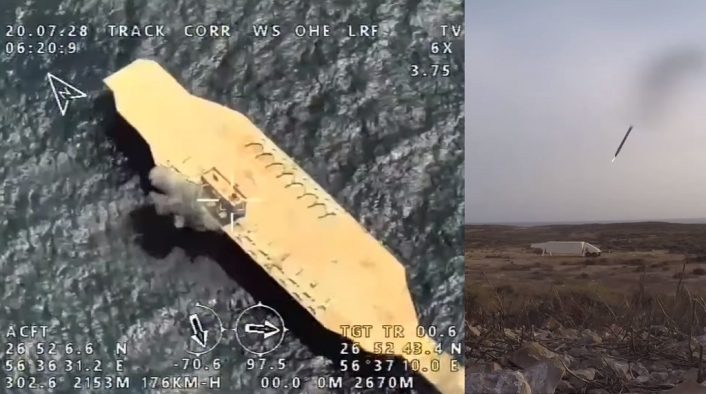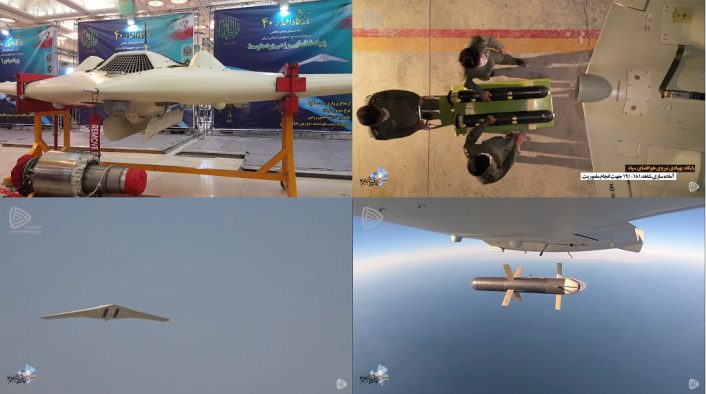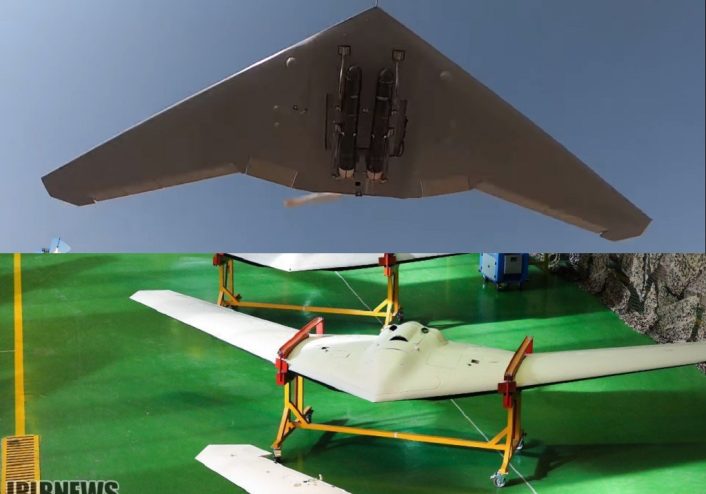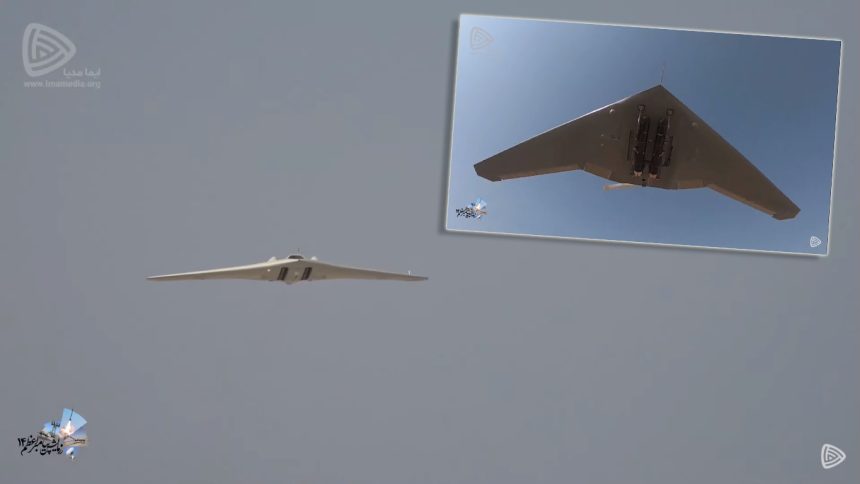The drones, reverse engineered from the captured U.S. stealthy RQ-170, were filmed during the exercise which culminated in the attack on the fake aircraft carrier.
Earlier this week, the Islamic Revolutionary Guard Corps (IRGC) kicked off its annual exercise in the Strait of Hormuz. This year’s edition, called “Great Prophet 14”, included – again – an attack on a fake U.S. Navy Nimitz-class aircraft carrier on July 28, 2020.
The fake ship was seen for the first time in 2014, when it was built as a movie prop, then blown up during Great Prophet 9 exercise in 2015 and repaired to be used again this year near the port city of Bandar Abbas. Another target seen in the videos of the exercise is a replica of the AN/TPY-2 missile defense radar, the eyes of the Terminal High Altitude Area Defense System (THAAD).
During the exercise, the IRGC used different weapons and platforms, including multiple types of short-range ballistic missiles, Nasr-1 anti-ship missile (copy of the Chinese C-704) with a 22 km range launched from an Agusta-Bell AB-206 (or the Iranian copy Shahed-278), ground-launched anti-ship cruise missiles, commandos both rappelling from an Mi-17 and parachuting on the fake carrier’s deck, combat divers and swarming fast boats, Su-22M4 with glide bombs, drones and even a surveillance satellite, although there is no concrete evidence to support this latter claim.
Just a #China🇨🇳origin C-701 (#Iran 🇮🇷 Kosar) Anti-Ship Missile integrated on a #US🇺🇸 origin Bell-206 (#Italy 🇮🇹 AB-206) operated by #Iran 🇮🇷 IRGCN apparently against a mock #US 🇺🇸 aircraft carrier target pic.twitter.com/9HUcjUc3CP
— Joseph Dempsey (@JosephHDempsey) July 28, 2020
Reportedly, three missiles splashed down in the waters near Al Dhafra Air Base (UAE) and Al Udeid Air Base (Qatar), prompting them to switch to a high alert posture.
Two bases in Middle East housing U.S. troops and aircraft went on high alert when 3 Iranian missiles splashed down in waters near the bases Tues. as part of Iran’s military exercises: official
Missiles landed “close enough” to Al Dhafra in UAE and Al Udeid in Qatar for concern
— Lucas Tomlinson (@LucasFoxNews) July 28, 2020

The most interesting aspects about the latest iteration of the drills, are the drones that took part in it.
Apart from the already known Shahed-129, a Medium Altitude Long Endurance (MALE) UAV that appears to be a hybrid of the Israeli Hermes 450 and the US MQ-1/9 Predator, what really stood out are the Shahed 181 and Shahed 191, developed from the RQ-170 captured by Iran in 2011. The American stealthy UAV, dubbed the “Beast of Kandahar” when it was first spotted in Afghanistan in 2007, was either hijacked via GPS spoofing, as claimed by Iran, or, most likely, crash landed because of an unknown failure and later found by the IRGC.
Before we continue, it is important to note that the videos of the drones during this week’s exercise are mixed with videos from another exercise carried out last year in the same area, so it may be difficult to confirm which images were actually recorded during “Great Prophet 14”.
It confirms there are jet (top line if 1st pic) and propeller (bottom line) versions that are both launched using vehicle-mounted racks pic.twitter.com/kvS9fFhkWl
— Jeremy Binnie (@JeremyBinnie) March 27, 2019
Once they got their hands on the RQ-170, the Iranians immediately started to reverse-engineer the aircraft, creating a full-scale exact copy that they called Shahed 171 Simorgh (Phoenix), unveiled in 2014. Another copy of the RQ-170 is the scaled down, about 60% of the original size, Shahed 161, called also Saegheh (Thunderbolt) and unveiled in 2016. This drone presents some differences, mainly the absence of the two fairings on the sides of the air intake and landing gear, and can be armed with four Sadid-1 TV-guided anti-tank missiles mounted semi-recessed under the fuselage.
After that, the next to be developed were the two drones seen during this week’s exercise, the Shahed 181 and Shahed 191, both called also Saegheh-2, which are essentially the same aircraft except for the engine and weapons’ placement.
Like the S-161, both UAVs are smaller than the original RQ-170 copy. Some analysts suggest that the drones may be made of fiberglass.

The S-191 is powered by a micro turbojet engine which Iranian media claim is capable of pushing the UAV up to 300 km/h at 25000 ft, with an endurance of 4.5 hours and a combat radius of 450 km. The UAV can mount an EO/IR (Electro-Optical/InfraRed) turret under the nose that however seemed to miss in the photos from the exercise (but a closer look still shows a panel for mounting the turret). According to the Iranian media, the drone can also carry a Synthetic Aperture Radar (SAR) turret instead of the EO/IR turret. It is interesting to note that both turrets have a heat sink that protrudes from the upper part of the fuselage, just in front of the engine’s air intake.
Instead of using a normal landing gear, the S-191 uses two retractable skids, but it also has a parachute to be used when a runway is not available. The takeoff is performed by using a rail installed in the back of a pickup truck, which then speed up on a runway until the UAV lifts off. Some earlier versions of the S-191 missed the two elevated fairings on the sides of the air intake.
The weapons are installed in two internal bays (which sometimes lack their doors, remaining open for the entire flight and thus nullifying the drone’s claimed “stealthiness”), each capable of holding a Sadid-342 guided glide bomb with fragmentation warhead, which is also extremely similar to the Sadid-1 anti-tank missile, so much so that often is difficult to discern one from the other in the photos (the same difficulties are also valid when identifying the S-171 and S-191 UAVs, with the only external differences being the size and the different landing gear). According to some analysts, the weapon could use “man in the loop” guidance.

The Shahed 181 is a variant of the S-191 propelled by a piston engine and with a different air intake design than the S-191 and missing fairings on the sides of the air intake. The retractable skids are replaced by four fixed skids, along with the weapon bays replaced by semi-recessed attaching points between the skids. Apart from these differences, the two airframes are identical.
New video from the defence exhibition, showing extended footage of the 2018 strike against ISIS. Opening/closing of bay, footage of city lights below and landing are shown. At the start service ceiling of the Shahed-191 is listed as 25,000 ft & 300 km/h is the cruise speed. pic.twitter.com/NYtLuZBLTI
— Aᴍɪʀ (@AmirIGM) February 7, 2019
Iran claims to have used the jet powered S-191 operationally to attack unspecified terrorist targets in eastern Syria in October 2018, with a video of the drone flying over an unspecified city at night and showing a weapon drop and the bay’s doors closing before landing on its skids on a runway. The prop-powered S-181 was instead used in February 2018 to infiltrate Israel from Syria and was subsequently shot down by an IAF Apache helicopter, prompting retaliatory strikes that resulted also in the loss of an F-16I Sufa.
با دیدن این فیلم، از دقت موشکها و بمبهای ایرانی لذت ببرید ✌🇮🇷✌#سپاه pic.twitter.com/XV3RuoMDw6
— Hossein Dalirian (@HosseinDalirian) July 29, 2020
Other than the drones, a new weapon seen for the first time in operation is the Yasin GPS/Glonass/INS guided glide bomb with a 300 kg warhead and range claimed to be between 50 and 100 km. The Su-22M4 was seen carrying a single bomb under the inner left pylon, with what could possibly be a datalink pod under the inner right pylon. Interestingly, the Su-22’s cockpit was upgraded with the addition of Garmin Aera and 430 GPS systems and another unknown radio system.
There’s also this… what looks like infrared view, but I’m no expert in satellite imaging signatures so I hope someone else can chime in. But for example in the first image, you can clearly see the aircraft. 3/ pic.twitter.com/lsQeAqKVnH
— Aᴍɪʀ (@AmirIGM) July 29, 2020
The last claim made by the IRGC during “Great Prophet 14” is the usage of a Nour satellite to monitor the exercise. Video distributed by Iranian media show the satellite’s orbit, designated “IRAN_SAT” in the graphics, showing a conic shape that could be a representation of the satellite’s field of view. The same video shows what is claimed to be satellite recon imagery of Al-Udeid Airbase in both the visible and thermal spectrum, but it is difficult to prove their authenticity.









